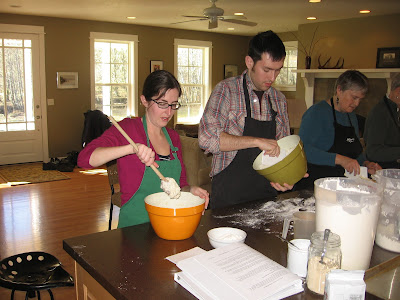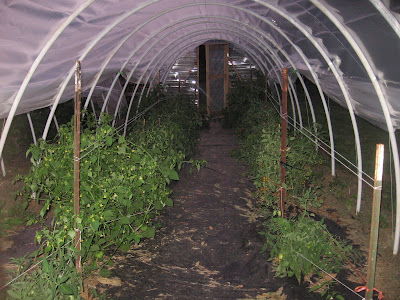If you know anything about our passion for and history with
bread and pizza baking, then you probably figured that at some point we would
graduate to a wood-fired oven. It was in 1974, while living in Omaha
that we baked our first pizza. A few
beers had been consumed that evening but not so many as to prevent me from
recalling the details of that venture. Our
friend, David Williamson was helping out and decided that we needed to throw the dough at
the wall to see if it was ready. (Apparently he thought it was akin to that old adage about throwing pasta against the wall to see if it's ready.) Deeming
that it was, we stretched the dough into a pan, topped it, put it in the oven and waited with bated
breath, all the while consuming more beer. Twenty minutes later, the moment we had anxiously
waited for arrived and we marveled with delight as I removed it from the oven. Then, we watched in horror as it slipped off
the pan and ended top side down on the floor!
By that time enough beer had been consumed to influence our judgment. We
just scooped it up, put it back on the pan and figured that a few minutes in a
hot oven would make everything ok.
T
hat night was the first step in my quest for a better
pizza. It has been a delicious journey
as we have experimented with different formulas, different flours, pans, baking
stones and a variety of oven tricks and
gimmicks to simulate a professional pizza oven.
For many years now we have served and enjoyed our Sicilian sheet pan
pizza.
It’s not a NY thin crust nor a Chicago deep dish but more of a focaccia with traditional pizza sauce and toppings. Don’t get me wrong. We are not abandoning “old faithful.” She has fed us and our guests well over the years and brings comfort like a pair of old slippers. What makes this pizza great is its taste, texture and accessibility. This is the pizza that we teach in our Artisan Bread Baking Class so that anyone can have great pizza at home.
It’s not a NY thin crust nor a Chicago deep dish but more of a focaccia with traditional pizza sauce and toppings. Don’t get me wrong. We are not abandoning “old faithful.” She has fed us and our guests well over the years and brings comfort like a pair of old slippers. What makes this pizza great is its taste, texture and accessibility. This is the pizza that we teach in our Artisan Bread Baking Class so that anyone can have great pizza at home.
B
ut as the saying goes, “variety is the spice of life”. And when the craving for a Neapolitan or NY
slice comes on, with its’ crusty bottom and smoky charred blisters, nothing
else will do. Unless you live in a town
with purveyors of such pizza then you do it yourself or do without.
Visions of a backyard wood-fired brick oven have filled my
head for years. It’s the Holy Grail for bread bakers. But the costs, the time to build it, not to
mention a lack of building skills have made that vision just a pipe dream. In a recent Google search for wood–fired
ovens I stumbled across this beautiful wood-fired oven.
A number of things intrigued me about it. I loved the design and stainless steel seems
like a good thing in our rainy climate.
It’s portable. I could move it to different areas on our
property depending on the event. Seems
like it would be a natural next to the bocce court.
We could possibly transport it to your yard for a catered pizza event.
We could possibly transport it to your yard for a catered pizza event.
It’s made locally. We
met with Todd Millar, the creator of
the oven at his home and shop in Yacolt,
WA. Todd is an amazingly talented and creative
young man with a passion for excellence.
Not only does he produce wood ovens but espresso machines and wood
roasted coffee beans. His coffee roasting earned him a write up in Saveur Magazine last year. Oh and did I mention his awesome barley
wine? And if that’s not enough, I would
be remiss in not mentioning Todd’s after-sales support. That’s almost as important to me as a consumer
as the product itself.
It’s practically plug and play. The only assembly required was the stand and
for that we are grateful to Ed and Theresa Videan. (You can bet they have some serious pizza points in their account.)
And now the real work begins. We have to learn how to use the darn
thing. It’s not just flipping a switch
and turning the temperature up and down as we please. We have fired it up three times and realize there is a learning curve here. It’s very interactive. You can’t just throw a pizza in there and walk
away from it. It requires frequent
rotation and repositioning, a good exercise in mindfulness.
N
ow here’s the fun part and you are going to love this. We need to practice. Kitty and I cannot eat pizza every night and
even if we could, it’s not practical to fire up the oven for just a couple of
pizzas. So, we are recruiting
volunteers. Volunteers that like to eat
pizza and offer critical feed back. Of
course our disclaimer is that perfection is not guaranteed. We have had two events so far. We have received high marks for taste and
quality but I have given myself low marks for pizza tossing, work flow and wood and heat management.
I
f you would like to be a Volunteer Pizza Critic, here’s what
you need to do.
- Leave a comment here on our blog.. Tell us about your favorite pizza.
- If you have a Facebook account and have not already done so, “Like” our Inn At Crippen Creek Farm Page.
- Send us an email to crippencreekfarm@gmail.com with a subject line “Volunteer Pizza Critic”. Make sure you include your name and phone number and of course none of that information will be shared, sold or otherwise distributed.
W
e will run our tests in groups of 6-10 people for several
weeks so get in on this before we get it mastered. Meanwhile enjoy some pictures from our
wood-fired adventures.
Artichokes and mushrooms
Mushroom and Italian Sausage
Spinach and Pancetta
Pepperoni and onion
Pears and Gorgonzola
Ciabatta
And it's not just for pizza and bread!














































